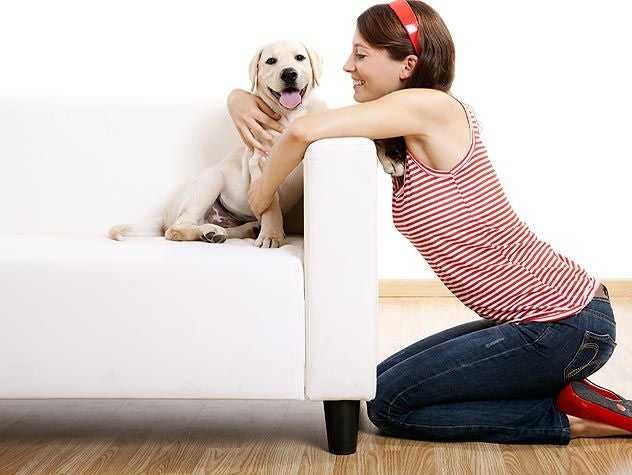How To Dog Proof Your Home

A new pet parent must prepare their home for their new arrival just like any other new mom or dad. Pet-proofing your home is key to having a happy, healthy pet.
Puppies get into everything. When you bring a dog home, their world gets bigger, and the best way to learn about the world is by exploration. Dogs explore with their eyes, ears, nose, and mouth. When puppies want to explore something, one technique usually always gets used, putting it in his mouth. We explore objects by touching them with our hands and moving them around, dogs do the same activity but use their mouth to figure it out.
The following tips for a new puppy can help ensure that your home is ready for your new four-legged family member.
Avoid Hazards
As mentioned above, it’s important to know how to puppy proof your house. The first place you should check is under your sink, or anywhere else you keep household chemicals. The following poisons should be stashed in a pet-proof cabinet:
- House plants (dieffenbachia, philodendron, hyacinth)
- Pesticides
- Antifreeze
- Rat and mouse poisons
- Mothballs
- Fabric softener sheets
Other common household items can be poisonous to pets, and should be kept out of their reach:
- Medications
- Potpourri oils
- Cigarettes
- Coffee grounds
- Alcoholic drinks
- Chocolate
- Electrical Cords
- Household Cleaners
Surprisingly, even small doses of chocolate can be lethal for dogs. Symptoms of chocolate poisoning may include vomiting, diarrhea, frequent urination, increased heart rate, convulsions, and seizures. Vomit is a clear indicator of other types of poisoning. Tell your vet if your pet’s vomit has an odd odor, color, or consistency.

Arm Yourself for Accidents
If your pet does vomit or has bathroom accidents as she adjusts to life in her new home, you will want to have on hand an enzyme cleaner for tackling pet messes. BISSELL’s Pet Stain & Odor Remover is ideal for cleaning up feces, urine, and vomit. And if the thought of cleaning up pet accidents makes your stomach churn, consider bringing home a BISSELL SpotBot Pet before you bring home your new pet. Its hands-free operation does the dirty work for you!
For cats, hairballs are also a fact of life. Talk with your vet about lubricants, which will help your cat eliminate swallowed fur and prevent health problems, such as an intestinal blockage.
Choose Proper Toys
Dogs love to chew on everything — even your favorite pair of shoes! However, chewing is a necessity — it keeps dogs occupied and relieves pent up anxiety. So bring home a proper chew toy before Fido picks another favorite item in your house to chew on. Keep in mind:
- Rawhide, hooves, and made-for-dog chew toys fulfill the need to chew and are good for her teeth and gums.
- Don’t give your dog old shoes, socks, wood, or children’s toys. It’s hazardous to her health and teaches bad habits.
- Turkey, chicken and steak bones are choking hazards.

Other Tips
- Trash-can smorgasbord. Buy a tall garbage can with a closing lid. Do not expect your dog to resist the temptation of an all you can eat scrap buffet. Dogs are natural scavengers. Time to change your routine if you are not good at taking out the trash. Consider putting food scraps in a smaller bag and taking them out right away. You don’t want to ever be the pet owner who finds their dog eating cooked chicken bones after you had wings during the game.
- Surface area can be the key. If you own a beautiful decorative rug it might be time to roll it up for a few months. Think about your dog spending time on a surface that is easy to clean and manage for when accidents happen, because they will happen.
- Start small and earn freedom. Confine your dog in small spaces at first, like a crate, single room, gated area, or small area of your home. This will ensure you are able to control the space and build good habits before you give your puppy full access to the house. Baby gates work great for blocking off a room to keep a puppy in or out.
- Numbers game. You know what you don’t want your puppy to chew on, so now it is time to experiment with objects, chews, and feeder toys that will encourage chewing on acceptable items. And keep it fresh. If your pup grows tired of the objects you got at first, put them away for a while and re-introduce them in a few weeks.
As your puppy ages and you start to have successful potty routines, less chewing and an attentive relationship, start introducing him to different areas of the home while you are able to supervise. Try short sessions with more and more freedom before you decide to just open the whole home up to him for an entire day.
Puppy proofing and careful management of your environment can save you a lot of time, money, and stress. Preventing bad habits from becoming normal is more effective than trying to catch a puppy in the act every time they make a mistake and lecturing him on what a naughty scoundrel you think he is. Don’t forget to give him lots of positive feedback when he makes great choices. This will define your relationship.
Knowing what to expect and following these few steps will help keep your cat or dog healthy and ensure a happy pet and family.